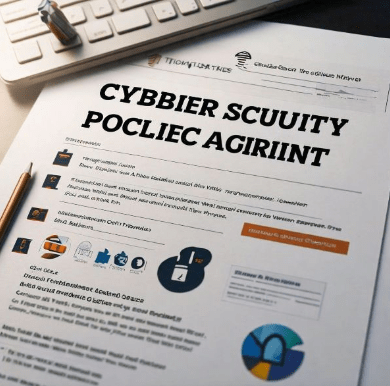Cybersecurity policies are crucial for safeguarding data and guiding employees in their role. From startups to enterprises, they help defend against hackers and threats.

We discuss here the process of creating practical cybersecurity policies and procedures that help you set and meet your organization’s goals in this blog.
1. Clarify Purpose and Scope
Every policy should have a defined purpose. It may be able to answer this simple question, “Why do I need this policy?” It may be to keep sensitive data secure or due to adherence to regulations. Having identified the purpose, define the scope. Who does this policy affect? Does it include all employees, departments, or only a few of each?
Example:
Purpose: To establish best practices for password creation and security to prevent leakage of sensitive information.
Scope: This policy extends to all employees, contractors and vendors who have access to the corporate networks.
2. Compliance with Regulatory Requirements
It is critical to identify the legal and industrial requirements that apply to your organization. Ensure that your policies are complaint to standards, such as GDPR, HIPAA or ISO 27001. Compliance does not only keep you from fines but also increases the credibility of your organization.
3. Define Roles and Responsibilities
Clarity is key. Define who is going to implement and enforce the policy. This could be the IT team or the security officers or employees specifically. And what should each of them do in terms of reporting incidents or violation of policy.
Example:
The IT department has the task to regularly audit the password policy but it is the job of every employee that the password chosen complies with the stated rules.
4. Use Plain Language
Your policy should be plain and direct, avoiding the use of jargon or technical terms unless essential, in which case define them. A well-written policy can be widely understood in the workplace.
5. Define Policy Statements and Controls
Articulate clearly what behaviors and actions are expected. For example, you may declare that users must change passwords every 90 days. Describe technical controls that would be implemented to support these policies: for example, encryption methods, use of monitoring tools.
Example:
Policy Statement: All employees will apply MFA when accessing sensitive information
Control: Password and one-time code verification shall be enforced for access using MFA.
6. Define Procedures and Guidelines
Employees must follow specific steps to follow the policy. They should report any security breach immediately by following the reporting process. They must also create strong passwords using recommended guidelines. Ensure that procedures are workable and straightforward.
7. Define Penalties and Enforcement
Clearly explain what happens when someone breaks the policy, like disciplinary action or even termination. Outline also the monitoring and enforcement plan of the policy by regular audits, automated tools, or other techniques.
Lack of compliance by the employees could lead to disciplinary action, including possible termination.
8. Establish a Review and Update Cycle
Cybersecurity is an evolving area, and your policies should, also. Include a schedule for regular review–at least annually and after significant changes in the organization.
Example:
This policy will be reviewed annually or whenever major changes occur in technology or regulations.
9. Include References and Appendices
Attach any documents or references to external standards that may apply. This can include references to NIST or vendor agreements, for example. Templates and forms should be attached where applicable, too.

Important Considerations to Develop Good Cybersecurity Policies
- Tailored to Your Organization: Change policies to suit the needs and risk factors of your organization. Do not use generic templates which you simply adopt without adjusting as necessary.
- Balance Security with Usability: Policies should not be so restrictive or impractical as to invite disregard. For instance, if there is too much insistence on the same password change, a weaker password is picked.
- Involve Key Stakeholders: Communicate with departments such as HR, IT, and compliance to formulate policies that are definite and implementable.
- Common internationalizes Compliance with standards of ISO 27001 or the NIST Cybersecurity Framework, policies are in place.
- Flexibility and Adaptability Policies should adapt to changing threats and dynamics.
- Training and Awareness Develop your staff for updates on policies that are present in an organization.
- Incident Response Inclusion: Incorporate provisions for incident reporting and response so the employees understand how to act in case of a breach.
- Document Control: Maintain clear versioning of policies and control access to disallow unauthorized modifications.
Conclusion
Proper creation of cybersecurity policies and procedures are one of the most important aspects of defending your organization. You will be able to have effective cybersecurity policies by following these steps and thinking about these key factors that can support you with actionable policies in enhancing your cybersecurity framework. Remember that we i.e, Digi9 always ready to help you to create your organization policies and procedure.
Implementation of these guidelines in your organization will give the organization an immeasurably stronger security culture: protecting your assets but also making the digital space safer for all of you in this chain.







